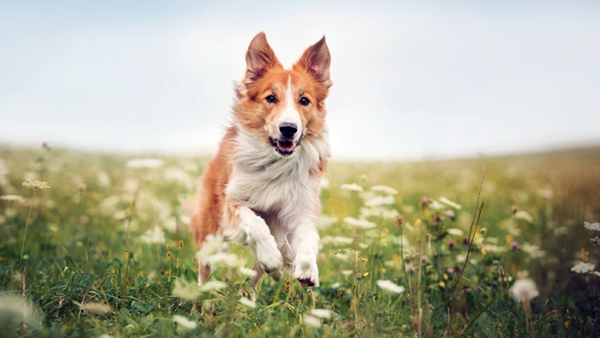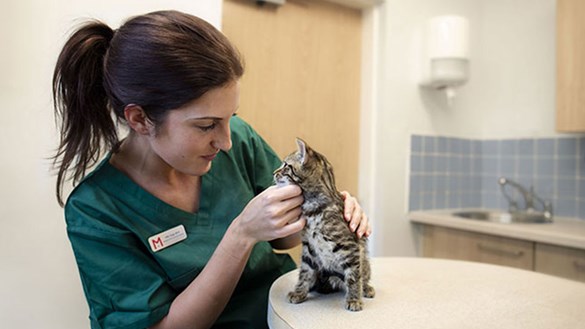Your Guide To Cat Nutrition
Feeding your cat the right diet can help keep them healthy for years to come. Understanding how much to feed your cat plays a key role in maintaining a healthy weight.

Not only does the right type of diet give cats all the nutrients they need, but it can also help improve their dental health and regulate their digestive system.
Keep reading for our advice on the best nutrition for your cat.
Which is the best diet for a cat?
Unfortunately, there’s no one answer to this, as the ‘right’ diet varies depending on your cat’s needs. All cats are obligate carnivores, meaning they need specific vitamins, minerals and proteins (for example taurine and arginine) that only come from meat. Without these essential nutrients, your cat can become seriously ill; a taurine deficiency can cause dangerous heart and eye issues and can even cause blindness.
How to choose the right food for your cat
There are various types of cat food available, but balanced, high-quality food is always better than a low-quality alternative. Whichever type you choose, look at the ingredients list. Your vet will be happy to offer tailored advice about your cat’s diet, taking into account their age, lifestyle, and any existing health conditions.
What human food is poisonous to cats?
It might be tempting to share bits of your treats with your cat, but before you do, ensure you learn which foods can be toxic to cats. The below list isn't exhaustive, and we'd strongly recommend checking our poisons guide.
- Onions
- Garlic
- Milk and dairy products
- Chocolate
- Grapes and raisins
- Dog food
Should I give my cat wet or dry food?
Many cats are notoriously fussy when it comes to food, so while there are benefits to both wet and dry, the decision may ultimately come down to their preference. Dry food is convenient to store and tends to be better for your cat’s dental health as the hard texture helps remove plaque and tartar, which doesn’t then build up around the gum line. It also contains much less water and has a higher concentration of nutrients, so you don’t need to feed as much.
On the other hand, cats often don’t drink enough water so wet food can help keep them hydrated. It’s also much easier to eat, for cats who are recovering from injury or operation.
Should I stick to the same food throughout their life?
Your cat’s nutritional needs change as they age, so you may need to alter their diet as they grow. For example, kittens under the age of one will need a diet that fuels their energetic lifestyle while supporting healthy brain, eye, and bone development. Similarly, cats over the age of 11 will need to switch to a food that supports their mobility and brain function.

Can diet help with health problems in cats?
There may be a time when your cat will need to be fed a special diet to help support health conditions such as diabetes, kidney issues, joint pain and arthritis, skin problems, digestive conditions, or food allergies. If your cat develops any of these conditions during their lifetime, you may need to switch their food to suit their needs. As always, your vet will be happy to recommend the best option.
If you do need to change their food for whatever reason, it’s important that you do so gradually as a sudden change in diet can upset their stomach and put them off their food. Start by adding a small amount of new food into their usual food. Gradually increase the amount of new food you give them (while decreasing the amount of old food) over the course of a week until they’re eating only the new food.
How much should I feed my cat?
The amount your cat should eat relates to their breed, age and size. All cat food has guidelines on the packaging, and this is usually a good place to start. You’ll then need to keep an eye on their weight to tell whether they’re eating too much, or too little. Roughly speaking, you should be able to feel, but not see, the last two or three ribs when looking from the side, and a clear waistline when looking from above. Your vet will also check your cat’s weight at their next health check to make sure they’re the right size.
Once you’ve settled on the right amount for your cat, it’s a good idea to weigh it out at the start of the day to avoid overfeeding. Cats are commonly overfed, leading to weight gain and further health issues, so this is a key step in maintaining a healthy weight.
How often should I feed my cat?
Once you’ve decided how much your cat should eat, you can then divide this into small meals throughout the day. This is generally flexible, but there are three different approaches you can take:
- Portion-control feeding involves dividing their daily amount into set mealtimes, usually two per day
- Free feeding where food (usually dry kibble) is available around the clock
- Timed feeding where food is put out for a specific duration and removed
Portion-control feeding is usually the best option for most cats as it can prevent overeating and gives owners the opportunity to keep an eye on their cat’s eating habits. If you still prefer free feeding over strict mealtimes, it’s important to measure out their recommended daily amount at the start of the day and top up the bowl from that amount. Once it’s gone, it’s gone.
If you have more than one cat, it’s a good idea to make sure that they’re all getting their fair share. It’s not uncommon for one cat to eat quickly and nudge the other out of the way.
Consistency is key, so always stick to your chosen feeding routine.
How many treats can I give my cat?
There’s nothing wrong with the odd treat, but it’s important not to overdo it as they can be highly calorific. Always opt for treats that are low in sugar and carbohydrates and limit the amount you give them. Treats should make up no more than five to 10 per cent of your cat’s diet. Larger treats can be broken up into smaller pieces, meaning you can still give your cat a few tasty rewards without feeding them too much.
If you do decide to treat your cat, it’s important to slightly reduce their regular food to balance out their daily intake.
Don’t forget to hydrate
Water is an essential part of your cat’s nutrition, and not drinking enough carries serious consequences. Unfortunately, many cats don’t drink as much as they should, so you may need to find ways to actively encourage them to stay hydrated.

A deep, narrow water bowl may touch your cat’s whiskers which can be uncomfortable, so switch to a wider, shallower dish. Additionally, make sure their water is always fresh, clean, and easily accessible to encourage regular drinking. Another good idea is to provide water bowls in different spots around your home – this should encourage your cat to drink more water.
If your cat still isn’t drinking enough, giving them wet food can supplement their water intake. In some cases, a lack of thirst can be a sign of an underlying condition. Always speak to your vet if you have any concerns.
Can I give my cat milk to drink?
It’s a common misconception that cats need to drink milk. They tend to be lactose intolerant, so giving them milk can cause digestive issues.
Cats only really need water for hydration and even the specially formulated cat milk isn’t great because it can be high in calories and cause weight issues. Stick to plenty of fresh, clean water and you won’t go wrong.
If you are concerned about your cat’s diet or have questions about the right food, speak to your local Medivet.
Cat Nutrition FAQ
Generally, a healthy, active 8lb (3.6kg) cat requires about 30 calories per pound, per day. So the average 8lb cat would need around 240 calories per day. It also depends on whether you are feeding your cat dry food or cat food, and the quality of food. We recommend asking your local vet for advice on nutrition.
Both wet and dry food have pros and cons. Wet food tends to be more expensive and a little messier but can be beneficial to cats prone to lower urinary tract disease, constipation and that are overweight. It’s also helpful for older cats who may have problems with their teeth or digestion. Dry food can be an efficient way to provide calories in thin cats and tends to be better for teeth health. If you have nutrition concerns, it’s better to talk to you vet as each cat is different.
Dry food is fine as long as it’s complete, and balanced. Cats that are fed a dry food only diet will need plenty of fresh water, especially if prone to urinary tract diseases.
Cats need a balanced diet with plenty of fresh water and will often go back to food eating little and often during the day. Cats need a good, meat-based diet to stay fit and healthy, and absolutely cannot be vegetarian or vegan. Ask your vet for the best diet suggestions for your cat based on their age, health and lifestyle.
From six months to senior, most cats should be fed twice a day – in the morning and early evening.
Cats who are overweight tend to do better on wet food than dry. If your cat suffers with urinary tract infections, or constipation, feeding them wet food may be beneficial.
There isn’t a single best diet that will suit all cats, as each cat is different and has individual needs. In general however, most indoor cats would do better with wet foods high in moisture and protein, and relatively low in carbohydrates. You should never attempt to feed your cat a vegetarian or vegan diet.

Cat and Kitten Microchipping
Read on to see advice on microchipping your cat, what to do if you move home or change your details and how to find cat and kitten microchipping near you
Read article
Medivet Healthcare Plan
On average our clients save an average of £225 with the Medivet Healthcare Plan.
Learn more

Our Pet Care Advice
At Medivet, we’re committed to providing trustworthy, expert advice that helps you care for your pet. Don't miss our latest advice for keeping your pets happy and healthy.
Search advice





